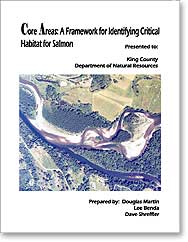Core Areas: A Framework for Identifying Critical Habitat for Salmon
 King County produced this report to help guide and prioritize management measures for salmon protection and restoration-- for example, habitat acquisition, habitat restoration and/or regulatory updates.
King County produced this report to help guide and prioritize management measures for salmon protection and restoration-- for example, habitat acquisition, habitat restoration and/or regulatory updates.Any given species is not evenly distributed in the environment-- rather, they aggregate into "core areas" when physical, chemical and biological conditions are good for mating, reproduction, rearing, feeding, migration and/or avoidance of disturbances such as floods and fire. When conditions aren't good, the species are absent or found only in low and unsustainable numbers. As a result, a fundamental goal of studying species is to identify and understand those factors that control distribution and abundance.
The Core Areas report applies concepts from the fields of conservation biology, landscape ecology and geomorphology to construct a framework for identifying areas of high use (i.e., core areas). Although it focuses on fish populations, the framework could be applied to any species. The framework was used to identify core areas for spawning chinook salmon (a currently ESA-listed species) in the Snoqualmie, Skykomish, Cedar and Green rivers of central Puget Sound to demonstrate of how the concept could be applied. It was found that geomorphic features (barriers, canyons, large tributary junctions and eroding cliffs) were strong determinants of the location of chinook spawning aggregations. The role of harvest, hatcheries and interspecific interactions (e.g., influence of sockeye spawning on or near chinook spawning sites in the Cedar River) was not assessed. Improved understanding of the effects of those factors could help to reduce variability in predicting location and extent of chinook salmon spawning aggregations.
Finally, it should be noted that areas not classified as core areas may have high importance. For example, a non-core area may be valuable for infrequent but biologically important straying or migration or for providing certain materials, such as clean water, sediment or wood debris, which sustain the biological value of a core area. Thus the role of non-core areas must be evaluated and, where necessary, their critical functions for core areas protected accordingly.
Core Areas: A Framework for Identifying Critical Habitat for Salmon is available in Adobe Acrobat format. For help using Acrobat files, please visit our Acrobat help page. The document is available in sections to reduce download time and minimize computer problems during and after download.
Download Here:
- Cover, credits, table of contents, preface, acknowledgements (502 Kb)
- Chapter 1, Core Areas: Habitats that Functionally Control the Spatial Structure of Salmon Populations (146 Kb)
- Chapter 2, The Spatial and Temporal Organization of River Habitats:
- Chapter 3, Spatial Patterns of Chinook Salmon Spawning in Relation to the Spatial Organization of Riverine Habitats and Core Areas:
- Introduction, Materials and Methods, and Results, pages 8-16 (3,068 Kb)
- Results, pages 17-26 (852 Kb)
- Results, pages 27-42, References (990 Kb)
- Chapter 4, Identifying Core Areas for Chinook Salmon (33 Kb)
- Appendix - Annual Peak Counts of Chinook Salmon Redds by Survey Segment (124 Kb)

 Translate
Translate